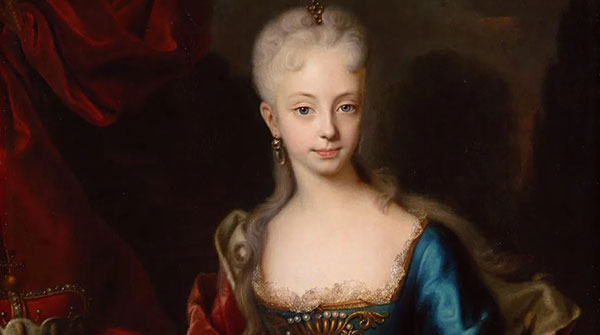Austrian ruler Maria Theresa a formidable and hugely influential figure
 If you watched the recently concluded PBS first season of Marie Antoinette, you’ll have noticed the vivid character portrayal of her mother. Although only occasionally on screen, Maria Theresa – the Austrian ruler of much of Central Europe – was a formidable and hugely influential figure. In modern parlance, she was one tough cookie.
If you watched the recently concluded PBS first season of Marie Antoinette, you’ll have noticed the vivid character portrayal of her mother. Although only occasionally on screen, Maria Theresa – the Austrian ruler of much of Central Europe – was a formidable and hugely influential figure. In modern parlance, she was one tough cookie.
Born in 1717 Vienna, Maria Theresa was the second child and eldest daughter of the Habsburg emperor, Austria’s Charles VI. Strictly speaking, she was an accidental heir; Charles’ only male issue had died before his first birthday. So when the male Habsburg line expired with Charles’ death in 1740, the dynasty became the House of Habsburg-Lorraine, Maria Theresa having married Francis, Duke of Lorraine, in 1736.
Charles had been very keen on the idea of maintaining the succession within the family, but he didn’t do much to prepare his daughter for taking the reins of power. Perhaps he assumed that being female, she’d focus on having children and leave the actual business of government to her husband. If so, he was very wrong.
 Austrian Empress Maria Theresa |
| History books |
| Caesar and Alexander – heroes, villains, or both?
|
| The Canadian who helped tame America’s Wild West
|
| The ignominious end of the Ottoman Empire
|
Maria Theresa certainly had children – 16 of them – but she also insisted on personally exercising power. She, not Francis, would call the shots. Like her contemporary Catherine the Great of Russia, she wasn’t interested in being merely a figurehead.
However, the throne Maria Theresa inherited wasn’t in the best of shape. The army was significantly under strength and the treasury was virtually bare. In the predatory world of Central Europe, the Austrian empire was thus a tempting target. And within a couple of months of Maria Theresa’s 1740 accession, Frederick II of Prussia moved to snatch the Austrian-ruled province of Silesia.
It wasn’t a matter of Prussia having any particular dynastic claim. It was just that the Habsburg possessions were deemed vulnerable, Silesia was prosperous, and Frederick wanted it. Historian Martyn Rady neatly encapsulates the prevailing dynamic, noting that “whereas in Western Europe, empires were built overseas, in Central Europe empires swallowed up the region, leading to a contest for hegemony fought out between the Austrian Habsburgs, Russia, and Prussia.”
And despite starting off on the back foot, Maria Theresa became as adept a predator as the rest. In the summer of 1772, she struck a deal with Catherine and Frederick to divvy up “more than a quarter of Poland and Lithuania’s territory and a third of its population.” Constrained only by the resources at her disposal, she played the game with enthusiastic vigour.
The Enlightenment is the name given to the 17th and 18th-century intellectual and philosophical movement that emphasized reason, the pursuit of knowledge and the questioning of the hitherto unquestionable. It manifested itself differently in different places.
Rady again: “In Britain and North America, the Enlightenment tended towards the extension of popular sovereignty, curbs on government, and the enlargement of individual liberty and of the rights of the citizen. In Central Europe, the Enlightenment tended towards the reverse – towards regulation and the subjection of the individual to the common good, as the ruler understood it to be.”
Maria Theresa was very much of the Central European mind in this regard. Modernization wasn’t a problem for her. Quite the contrary. But she wanted it approached in a way that would uphold, not subvert, the traditions and precepts she strongly believed in.
The entity she chose to emulate was the one she most feared – Prussia. As early as the 1740s, she began centralizing government along Prussian administrative lines. And there were changes to military recruitment, census enumeration and such. The modern bureaucracy was being born.
And when it came to religion, Maria Theresa took her Catholicism very seriously. There was nothing ecumenical about her perspective.
She shared the prevailing European antipathy towards Jews, even exiling them from Prague in 1745 and Vienna in 1775. Protestants, on the other hand, were apostates from the “true faith” and should be rescued by conversion. There was, for instance, an initiative to separate Protestant children from their parents “in order to save their souls.”
Marie Antoinette – Maria Theresa’s 15th child – was married off to the heir to the French throne in 1770. Being born into the royal family gave you privilege and material comfort. But it also made you an instrument of the state, susceptible to being deployed as alliance-building material in an arranged marriage to someone you’d never met.
Only 14 at the time, Marie Antoinette was in way over her head, which she subsequently lost to the guillotine in 1793. By then, though, her mother was long dead.
Troy Media columnist Pat Murphy casts a history buff’s eye at the goings-on in our world. Never cynical – well, perhaps a little bit.
For interview requests, click here.
The opinions expressed by our columnists and contributors are theirs alone and do not inherently or expressly reflect the views of our publication.
© Troy Media
Troy Media is an editorial content provider to media outlets and its own hosted community news outlets across Canada.

